Socio-Economic Condition of A Rickshaw Puller of Bangladesh-A Study on Dhaka City (original) (raw)

AMERICAN JOURNAL OF SOCIAL DEVELOPMENT AND ENTREPRENEURSHIP (AJSDE)
ISSN: 2836-0702 (ONLINE)
VOLUME 3 ISSUE 1 (2024)
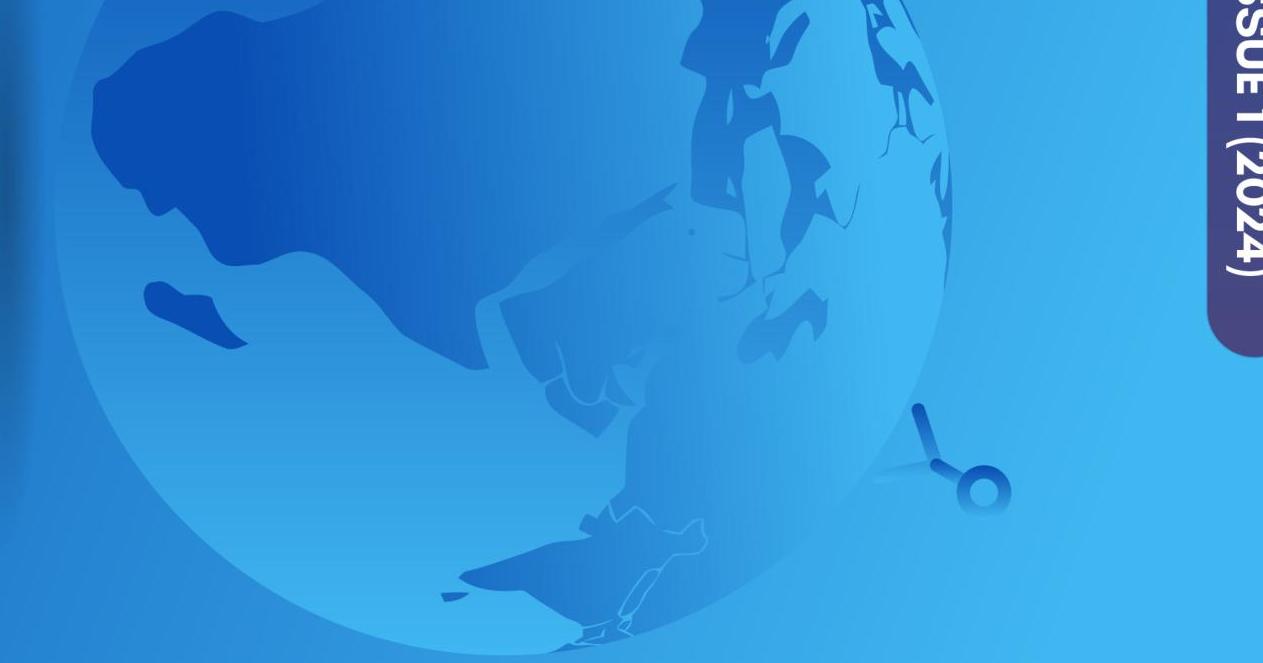
PUBLISHED BY
E-FALLI FUBLISHERS, DELAWARE, USA
Socio-Economic Condition of A Rickshaw Puller of Bangladesh- A Study on Dhaka City
Shuma Roy 1{ }^{1}, Md. Mostafa Kamal 1{ }^{1}, Tapan Kumar Biswas 1{ }^{1}, Swapna Chowdhury 1{ }^{1}, Jumman Sani 1∗{ }^{1 *}
Abstract
Article Information Received: July 30, 2024 Accepted: August 26, 2024 Published: October 09, 2024
Keywords
Socio-Economic, Employment, Income, Expense, Savings, Rickshaw Puller
ABSTRACT
Rickshaw is a very popular and essential transportation in Dhaka that assures significant job opportunities for the uneducated and poor people. When clean Dhaka is a burning issue to us where rickshaw plays a positive role by giving pollution free services. This profession attracts huge number of poor, illiterate and unskilled persons for easy way of cash earnings. This survey is being conducted to examine the socio economic conditions of rickshaw pullers in Dhaka city. We have considered different variables to complete this survey such as rickshaw pullers’ age, education, previous job, income, savings, expenditures, loans and others. This survey is being conducted based on primary data which has been collected from different areas of Dhaka city. Primary data has been collected through structured questionnaire from 100 rickshaw pullers of different areas in Dhaka city. Rickshaw pullers are one of the most disadvantageous and unlucky people who are involving in informal sector such as rickshaw pulling which is more stressful work for earning money. Majority of the respondents of this survey have come from different areas of Bangladesh like Barisal, Rangpur, Comilla, Nilphamary, Mymansing and others. Among the 100 rickshaw pullers, 66%66 \% respondents were in the ages from 26−5026-50 years and about 14%14 \% were under the ages of 26 years. However some older participants were also found in the survey. Most of the rickshaw pullers are married and their family members depend on rickshaw pulling for livelihood. Majority of the rickshaw pullers have come from the working background of agriculture and day laborers. High living cost and poverty force them to change profession and encourage them to choose rickshaw pulling to earn more money. From this survey it is found that more than 50%50 \% rickshaw pullers staying in Dhaka city with their family in rental house and remaining people select garage, mass or slum area to stay with other rickshaw pullers for saving money from rental cost. Majority of the rickshaw pullers pull rickshaw for seven days in a week, average working hours in a month is 211 hours and 53%53 \% of rickshaw pullers pulling rickshaw for 7 to 8 hours in a day. This survey shows that 76%76 \% of their total income comes from pulling rickshaw and 18%18 \% from other sources. After pulling rickshaw, they involve in other works like vendor or part time worker. Another 6%6 \% comes from other family members who are involved in as a maid or garments worker. However their net saving is only 3%3 \% and only 24%24 \% rickshaw pullers have the ability to save some money after meeting up all expenditures. They spend 78%78 \% of their total income for food and house rent. Under the balance of income issue, 57%57 \% of rickshaw pullers are staying in deficit balance of income. To overcome deficit balance of monthly income they give first priority to borrow money from their relatives. They also borrow money from bank to meet up the expenditures. For example, to manage dowry for daughter’s marriage, for crops cultivation or to build or repair home they also borrow. Repayment percentage is only 8%8 \% among the borrowers showing their inability which push them to debt trap for year after year. It can be summarized from the findings that taking rickshaw pulling cannot be a permanent profession considering physical stress. It can be taken as an alternative profession when no other ways are available for them. It cannot be regarded as a permanent way of overcoming poverty.
INTRODUCTION
The rickshaw, invented in Japan in 1869, is credited to Izumi Yosuke and two others, and its name comes from the Japanese word “jinrikisha,” meaning “humanpowered vehicle.” The rickshaw gained popularity in China and India as an affordable and efficient urban transportation option. Rickshaws arrived in Bengal in the early 20th century, becoming popular in cities like Dhaka. Rickshaws are a cultural symbol of Dhaka and Bangladesh, decorated with elaborate designs. Though rickshaw plays a significant role as a symbol of history and culture, Rickshaw pullers face challenging socio-
economic conditions like long hours, low wages, and lack of security. Socio economic condition expresses a person’s living standard in the economy. It can be low, medium or high. When a person belongs to a low socio economic status it means that his capability on financial, educational, social and in health resource condition is lower standard compared to the persons holding high socio economic status. Urban cities are considered as a central area of creating job opportunities basically in informal sector for the poor rural people. Rickshaw pullers in Dhaka, Bangladesh play a crucial role in the city’s economy and transportation system, providing affordable rides. A study
- 1{ }^{1} Faculty of Business Administration, University of Development Alternative (UODA), Bangladesh
- Corresponding author’s e-mail: jumman.sani@gmail.com
↩︎
- Corresponding author’s e-mail: jumman.sani@gmail.com
is being conducted to examine their daily lives, incomes, and challenges, with the goal of informing policies that could improve their livelihoods and social inclusion. This research will contribute to understanding labor, poverty, and urbanization in Bangladesh and advocating for the well-being of rickshaw pullers.
LITERATURE REVIEW
Several studies have been conducted regarding the socio economic condition of the rickshaw pullers in different region and on different prospective. Dhaka, the capital city of Bangladesh, is one of the fastest growing cities in the world. Dhaka has become one of the world’s megacities with a tremendous population increase due to unchecked and rapid urbanization over the past four decades (Roy et al., 2018). Migration is the main reason for increasing population in Dhaka city. Socio economic factors have been stronger reasons for migration basically from rural to urban area. In 2022, the share of rural population in Bangladesh remains nearly unchanged at around 60.29%60.29 \% which is defined by the national statistics offices. Majority of rural people involve in agricultural work or basically as a day laborer. But the return from this side is less and it has become harder to meet livelihood by this insufficient income. So, lower earnings motivated the poor rural people to change their profession and place. Mostly poor rural people prefer to move in Dhaka city to escape from the poverty and to provide financial supports to the dependent members of their family. According to World Bank report, approximately 3,00,0003,00,000 to 4,00,0004,00,000 people migrate to Dhaka city each year. Begum & Sen, (2005) stated that rural poverty force the poor rural people for migration from rural to urban area in search for better life, better job opportunity and better social services. It is observed that rickshaw pullers in Dhaka typically come from rural areas, driven to the city by poverty and lack of employment opportunities in their home regions (Rahman, 2010; Kabeer, 2005). The majority are male, with low levels of education, often lacking formal training or skills for other types of employment (Ahmed, 2014). Wadood & Mostafa, (2018) has found that low entry requirements encourage the poor people for migration and absorb themselves into the informal jobs such as rickshaw pulling, entry level works in readymade garments industries (this one is formal) or construction sites, running petty business besides the footpaths in Dhaka city. Naimul Wadood & Mostafa Tehsum, (2018) reported their study that ‘Informal sector mostly works as life line for the low skilled urban poor.’ Rickshaw pulling is one of the most popular professions in informal sector and it provides them relatively easier access to the urban market. For rickshaw pulling, no capital, training or skill is needed. It is estimated that nearly 1.5 million rickshaw pullers of Dhaka city and their family members are dependent on rickshaw pulling2. Rickshaw is the most convenient and affordable forms of transportation for short range travels compared to other vehicles such as bus, CNG,
private car or others. Majority of the rickshaw pullers are migrants and survive in the poverty level. According to the last survey conducted by BILS, the monthly average income of rickshaw puller in Dhaka city is estimated to be of taka 13,382/- of which 68%68 \% comes from rickshaw pulling (Rezaul karim and Abdus Salam, 2019). However their net income is less due to high expenditure of living cost. Begum & Sen, (2005) stated that a rickshaw puller spends 60%60 \% of their income on food, 22%22 \% on house rent. The remaining 18%18 \% is divided into clothing, children’s education, transport, loan repayments, rickshaw-related matters (such as repairs, fines and payments to the police) and health care. Rickshaw pullers’ spending on asset building is negligible. They try to save some money from their little earnings by purchasing food at lower price as best as possible. They select a living quarter with cheaper cost avoiding hygienic issues. High living cost in city areas force the permanent rickshaw pullers to engage their family members and children in household works for extra earnings. Moreover, the rickshaw pullers of Dhaka city are deprived of basic facilities, social needs and basic rights as labour (Rezaul Karim, Abdus Salam, 2019). They are facing negligence from the implication of different policies which are taken for the development of poor people. A rickshaw puller never gets any kind of compensation for major accidental incidents whereas for a worker in formal sector gets compensation and fringe benefits. In addition, rickshaw pullers suffer from different diseases such as fever, body pain, cough and pain abdomen as they are paddling rickshaw for the long time by taking unhealthy street food, inhaling polluted air and dust and works under heavy rainfall and hot sunshine. The purpose of this paper is to examine livelihood strategies of rickshaw pullers in Dhaka city by considering the factors such as income, food, education and health and make a proper and realistic plan on the basis of the findings to improve socio economic standard of rickshaw pullers and ensure a pleasant life of them.
Objectives
The general objectives of this study are to examine the socio economic condition, food pattern, educational status and health situation of a rickshaw puller in Dhaka city of Bangladesh. The following issues have been analyzed in this study to find out:
a. Socio and economic status of rickshaw pullers in Dhaka city.
b. Educational status of rickshaw pullers in Dhaka city.
c. Residential status of rickshaw pullers in Dhaka city.
d. Income of rickshaw pullers in Dhaka city.
e. Expenditure of rickshaw pullers in Dhaka city.
METHODOLOGY
A thorough investigation was carried out using structured questionnaires to evaluate the socio-economic status of rickshaw pullers in Dhaka city. The approach used for this study consists of the following procedures:
Survey Design
A specific survey was created to gather in-depth data on different socio-economic factors such as age, level of education, past employment, earnings, savings, spending, debts, and other details. The survey was tested on a small number of rickshaw drivers in a trial phase to guarantee clarity and thoroughness. Feedback was used to make required changes.
Sampling
A total of 100 rickshaw pullers were selected and data were collected from them for the survey. A purposive sampling method was employed to choose rickshaw pullers from various sections of Dhaka city in order to guarantee a diverse sample. The regions encompassed bustling markets, housing areas, and significant transportation hubs.
Data Collection
By doing face to face interviews with a structured questionnaire, data was collected to fulfill the objectives of the study. The data collected process was observed through out to assure more correct and authentic information. The survey continued for two months to ensure a detailed overview of the socio economic conditions of the rickshaw pullers can be obtained.
Data Analysis
The accumulated data was systematically recorded in a database for the purpose of analysis. The data was summarized using descriptive statistics including frequencies, percentages, and means. Additionally, crosstabulations were conducted to analyze the relationships between various variables.
The purpose of the study was explained to all interviewees and consent was obtained before the interview. The personal information of respondents will be protected and kept confidential. Following this methodology, the study aims to provide a comprehensive and accurate assessment of the socio-economic status of rickshaw pullers in Dhaka city and identify key challenges and opportunities where intervention is possible.
Findings and Result
Table 1: Age of the Dhaka city rickshaw pullers
| Age | Number | Percentage |
|---|---|---|
| 18−2518-25 | 14 | 14%14 \% |
| 26−3326-33 | 22 | 22%22 \% |
| 34−5034-50 | 44 | 44%44 \% |
| 51+51+ | 20 | 20%20 \% |
| Total | 100\mathbf{1 0 0} | 100%\mathbf{1 0 0 \%} |
Rickshaw pulling is a stressful job. Too much physical strength is needed to continue this job for a long time. The analysis in table 1.1 states that almost 80%80 \% rickshaw pullers aged between 18−5018-50 years. The average age is 34−5034-50 years that is of 44%44 \%. These findings indicate that the persons those who are physically capable involve in rickshaw pulling. It has also been found that some of the aged persons (20%)(20 \%) are engaged in this profession. The higher cost of living and poor socio economic condition force the aged persons to adopt this profession for survival.
Table 2: Marital status and family members of rickshaw pullers in Dhaka city
| Profile | Number | Percentage |
|---|---|---|
| Married | 81 | 81%81 \% |
| Unmarried | 19 | 19%19 \% |
| Total | 100\mathbf{1 0 0} | 100%\mathbf{1 0 0 \%} |
Almost 81%81 \% rickshaw pullers are married and 19%19 \% are unmarried. In reviewing family, it has been found that almost (75%)(75 \%) are dependent family members and remaining 25%25 \% are independent family members. Independent family members are not directly dependent on earning of rickshaw pulling.
Table 3: Educational status of the rickshaw pullers in Dhaka city
| Education Level | Number | Percentage |
|---|---|---|
| Below primary | 33 | 33%33 \% |
| Primary | 57 | 57%57 \% |
| Secondary | 10 | 10%10 \% |
| Total | 100\mathbf{1 0 0} | 100%\mathbf{1 0 0 \%} |
Majority (57%) of rickshaw pullers have completed primary education and 10%10 \% of them completed up to secondary level. According to the statistical data, 33%33 \% of rickshaw pullers are illiterate. They could not attain any level of education because of lower income and poverty.
Previous Occupation
Rickshaw pullers are engaged in varieties of occupations before starting rickshaw pulling. It has been founds that they come to Dhaka for searching jobs but adopt rickshaw pulling as an easy and available work. Before rickshaw pulling, 39%39 \% of them were involved in agriculture, 35%35 \% of them in day laborers and 12%12 \% of them in mills and factory work. Remaining 14%14 \% had no occupation.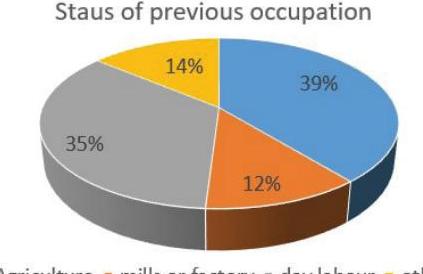
Figure 1: Status of previous occupation
Table 4: Occupation of the rickshaw pullers in Dhaka city
| Professional status | Number | Percentage |
|---|---|---|
| Permanent | 68 | 68%68 \% |
| Seasonal | 32 | 32%32 \% |
| Total | 100\mathbf{1 0 0} | 100%\mathbf{1 0 0 \%} |
About 68%68 \% of the rickshaw pullers are engaged in rickshaw pulling as a permanent profession. They are solely involved in rickshaw pulling only as no training and investment of money is required. Another 32%32 \% choose this profession as a seasonal work along with agriculture.
Table 5: Time in the year pull rickshaw in Dhaka city
| Time in the year | %\% of the respondent |
|---|---|
| 12 months | 68%68 \% |
| 6 months | 13%13 \% |
| 5 months | 1%1 \% |
| 4months | 15%15 \% |
| 3 months | 3%3 \% |
In this survey, the number of respondent is 100 . Among the respondents, 68%68 \% pull rickshaw throughout the year basically those who are permanent and rest of the 32%32 \% is not. In rural areas jobs are available during harvesting season with reasonable wage. So some rickshaw pullers get engaged there. In this survey, rest of the 32%32 \% rickshaw pullers pull rickshaw seasonally. Among them, 15%15 \% for 4 months, 13%13 \% for 6 months, 3%3 \% for 3 months and 1%1 \% for 5 months pulling rickshaw in Dhaka city.
Table 6: Days and hours of rickshaw pulling
| Days in a week | Permanent | Seasonal | Total |
|---|---|---|---|
| 7 days | 34 | 16 | 50 |
| 6 days | 25 | 8 | 33 |
| 5 days | 8 | 7 | 15 |
| 4 days | 1 | 1 | 2 |
| 68 | 32 | 100 |
Half of the rickshaw pullers (50%) pull rickshaw seven days in a week, 33%33 \% of them 6days in a week, 15%15 \% of them 5 days in a week and only 2%2 \% of them 4 days in a week among the respondents. It has been revealed that the permanent rickshaw pullers’ pull rickshaw more days in a week than that of seasonal rickshaw pullers.
Table 7: Hours in a day pulling rickshaw
| Hours | %\% of the respondent |
|---|---|
| 6 hours | 14%14 \% |
| 7 - 8 hours | 53%53 \% |
| 9-10 hours | 22%22 \% |
| 11 - 12 hours | 10%10 \% |
| 12+ hours | 1%1 \% |
It has already been mentioned that rickshaw pulling is an arduous job. There are three shifts in a day for the rickshaw pullers. They are usually pull rickshaw in different shifts. According to our survey more than half (53%)of the rickshaw pullers pulling rickshaw for 7 to 8 hours in a day, 14%14 \% for 6 hours in a day, 22%22 \% for 9 to 10 hours in a day, 10%10 \% for 11 to 12 hours in day and only 1%1 \% for more than 12 hours. Rickshaw pullers pull rickshaw more hours per day to meet up their daily expenses.
Residence of Rickshaw Pullers in Dhaka City
Earlier we have seen that almost all rickshaw pullers come from outside of Dhaka city. According to our survey, more than half ( 55%55 \% ) of the rickshaw pullers live in Dhaka city with their family in rental houses. It is to be noted that the rest of the rickshaw pullers stay in single in the city due to higher rental cost. About 18%18 \% of rickshaw pullers live in garages, 19%19 \% live in mess, 5%5 \% in slums and 3%3 \% in other areas with other rickshaw pullers. It is evident that rickshaw pullers live in Dhaka city in an awful condition.
Table 8: Ownership status of rickshaws
| Particulars | Number | Percentage |
|---|---|---|
| Owned | 19 | 19%19 \% |
| Rented | 81 | 81%81 \% |
| Total | 100\mathbf{1 0 0} | 100%\mathbf{1 0 0 \%} |
Ownership status means whether rickshaw pullers own any rickshaw personally or pulling it as rent. According to the findings, majority of the respondents ( 81%81 \% ) pull rickshaw on rent and pay to the rickshaw owner BDT 120/ to BDT140/ per day, only 19%19 \% respondents have a rickshaw personally. As the majority of Dhaka city rickshaw pullers are migrated from different areas of Bangladesh and stay in the city under temporary arrangements. So it is difficult for them to own and maintain a rickshaw in the city because of lack of place and higher costing.
Table 9: Monthly income status of rickshaw pullers
| Source of income | Amount (Tk.) | Percentage |
|---|---|---|
| Income from rickshaw pulling | 1904400 | 76%76 \% |
| Other source | 465600 | 18%18 \% |
| Income from family | 150500 | 6%6 \% |
| Total | 2520500\mathbf{2 5 2 0 5 0 0} | 100%\mathbf{1 0 0 \%} |
Among the rickshaw pullers, 76%76 \% of their total income comes from rickshaw pulling, 18%18 \% comes from other sources of income and 6%6 \% of income comes from other family members. Majority of them ( 84%84 \% ) earn up taka 25,000.00 per month. It is mentionable that their per day’s average income is 700 taka to 800 taka. About 4%4 \% of them earn less than taka 10000,20%10000,20 \% of them earn taka
10,000.00 - taka 15,000.00, 34%34 \% of them earn taka15, 000.00 - taka 20,000.00, 25%25 \% of them earn taka 20,000.00 - taka 25,000.00,11%25,000.00,11 \% of them earn taka 25,000.00−25,000.00- taka 30,000.0030,000.00 and 6%6 \% of them earn more than taka 30,000.00
per month. Although their nominal income appears to be higher but their real income is less because of high living cost.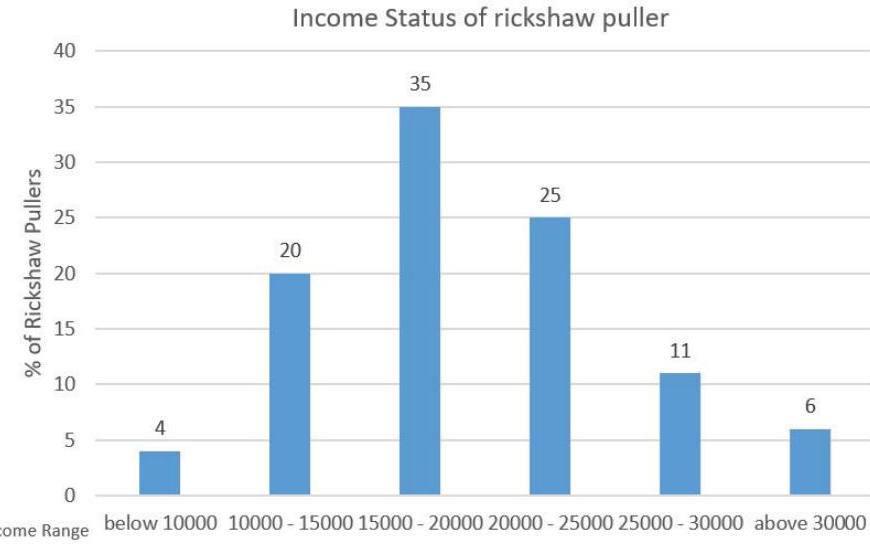
Figure 2: Income Status of rickshaw puller
Table 10: Expenditure and saving status of the rickshaw pullers
| Expenditure items (monthly) | Amount | Percentage |
|---|---|---|
| House rent | 389300 | 24%24 \% |
| Food | 872000 | 54%54 \% |
| Medical | 55413 | 4%4 \% |
| Education | 197317 | 12%12 \% |
| Festival | 45837 | 3%3 \% |
| Clothing | 47873 | 3%3 \% |
| Total | 1607740\mathbf{1 6 0 7 7 4 0} | 100%\mathbf{1 0 0 \%} |
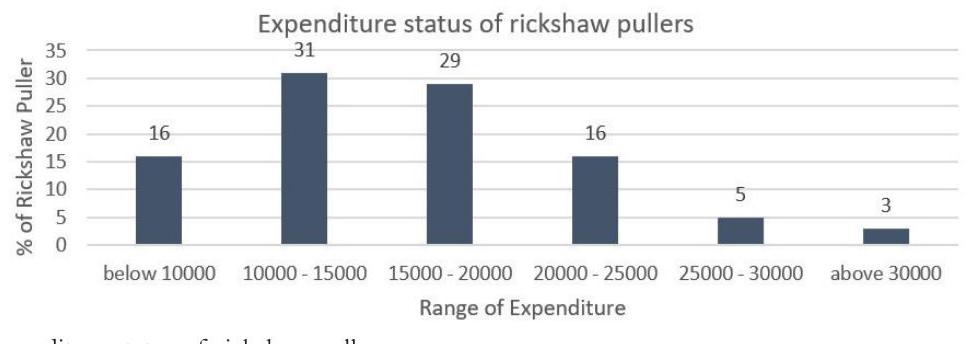
Figure 3: Expenditure status of rickshaw pullers
Rickshaw pullers spend major portion of their income for their livelihood. In our survey, we consider six common expenditure areas such as house rent, food, medical, education, festival and clothing. We collected monthly expenditure on following areas to know their socio economic condition. This report shows that 16%16 \% rickshaw pullers spend below ten thousand taka per month, 31%31 \% expend ten to fifteen thousand taka per month for food and other expenses, 29%29 \% expend fifteen to twenty thousand taka per month for maintaining livelihood, 16%16 \% spend from twenty to twenty five thousand, 5%5 \%
spend from twenty five to thirty thousand taka and 3%3 \% expend more than thirty thousand. Higher cost of food and house rent in Dhaka city, their maximum earnings spend only to meet up food consumptions and house rent purposes. Our findings show that 54%54 \% of income spend for food, 24%24 \% of income for house rent, 12%12 \% for education, 4%4 \% for medical, 3%3 \% for festival and 3%3 \% for clothing purposes as monthly expenditures. After that there remains almost no allocation for spending on child education and medical treatment. That’s why they suffer in various diseases for the lack of proper treatment.
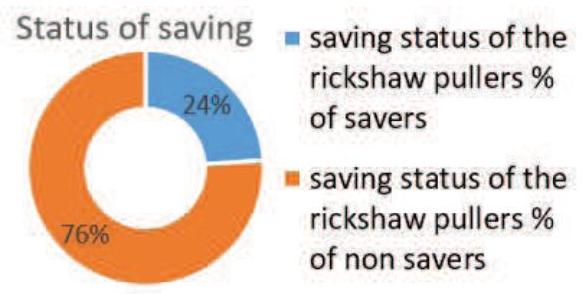
Figure 4: Status of Saving
Among the informal job sectors, rickshaw pulling is one of the hard working professions. Although they earn a significant amount of money but still their savings is not remarkable. For the high living cost they cannot save from the earnings for future expenditure. In our report, only 24%24 \% respondents are able to save some money and their net savings of total income is 3%3 \%. Rest of the respondents (76%)(76 \%) has no deposits for future use.
Property Status of Rickshaw Pullers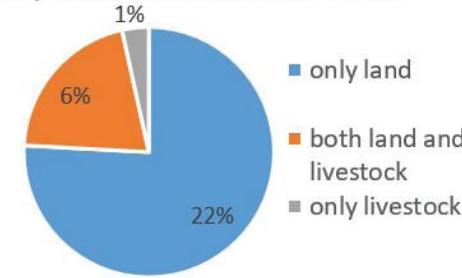
Figure 5: Property status of rickshaw pullers
The rickshaw pullers have a negligible amount of property such as livestock, cultivable land or homestead. Among the 100 rickshaw pullers, 29%29 \% have some property and remaining 71%71 \% have no property. It has been seen that only 22%22 \% have land, 6%6 \% have both land and livestock and only one respondent mentioned that he has only cattle. Overall it proves that the ownership of properties of rickshaw pullers is extremely poor and they are too much affected group to bear any kind of economic shocks.
Table 11: Economic solvency of the rickshaw pullers
| Strategies to manage monthly deficit | |
|---|---|
| Sources | Percentage |
| From relatives | 20%20 \% |
| From NGO’s/ co-operative | 16%16 \% |
| Shops | 6%6 \% |
| Others | 18%18 \% |
Economic solvency of the rickshaw pullers is not so good. They collect their monthly deficit between income and expenditure from different areas such as relatives, NGO’s, shops and others. It has been found that among the respondents those who have deficit balance, 20%20 \% take help from relatives, 16%16 \% from NGO’s, 6%6 \% from shops
and 18%18 \% from others. Normally they borrow money from these sources specially to cover daily expenses.
Table 12:
| Strategies to manage loan | |
|---|---|
| Sources | Percentage |
| From bank | 10%10 \% |
| From others | 32%32 \% |
They also take loan from banks, co-operative or garage owners to meet up urgent expenses such as to manage dowry for daughter’s marriage, to purchase any kind of assets or for repairing houses. It has been found that among the borrowers, 10%10 \% borrow from banks and 32%32 \% from other sources. But the repayment percentage of only 8%8 \%, which shows that they always live in financial crisis.
CONCLUSION
Rickshaw pulling is one of the most sought professions in informal sector in Dhaka city. For easy earnings and availability, the profession attracts the needy persons as well as to the new entrants in the city. No education, special skill, license or training is needed to enter into this profession. The overall analysis of this survey reveals that the rickshaw pullers are one of the poorest people in the society. Their socio economic condition and living standard of the rickshaw pullers is poor compared to the condition of similar income peoples in this society. They lead a low standard lifestyle in the society and face many challenges during pulling time. Unfortunately they are totally unaware about their rights and hence unable to place their demand in any forum as they are not organized. More than one million unskilled labors is involved in this profession. So this sector should not be left unattended by the government.
Availability of alternative employment in rural areas, improvement in public transport, and development of skills to unskilled migrants may discourage the poor from entering into this occupation. At the same time govt. and NGOs should organize different campaigns to create awareness among the rickshaw pullers about their child’s education to improve their socio economic conditions and discourage them for not selecting this occupation forever.
RECOMMENDATION
Rickshaw is one of the primary and most acceptable transports basically for short distance movement in Dhaka city. Poor people take this profession as an easy way to earn money for their livelihood. But it cannot be treated as a sustainable profession to reduce poverty. Some of the respondents come to this profession because of extreme poverty and some of them come for making instant earnings. In reality, it cannot be taken as a long run profession. So, some steps should be taken by the govt. to improve their present condition.
- Investment in manufacturing and other economic sectors in rural areas must be scale up so that job opportunity can be created for the persons those who are unemployed in their own localities.
- Education for the children and availability of vocational training program should be arranged to develop skill of rickshaw pullers so that they become motivated.
- Modern transportation facilities can be introduced like horn, indicator light etc with rickshaw to reduce collusion.
- Separate road lane can be arranged for rickshaws to assure more safety.
- Extra facilities like lower interest loan with easy clauses can be given to develop the socio economic conditions of rickshaw pullers like other section of people.
- Rickshaw pullers are unaware about their rights and have no training about traffic rules and legal system. So govt. should arrange training and counseling to the rickshaw pullers to improve their consciousness.
- Free training on traffic system, low cost meals and low cost living spaces can be arranged by government to patronize the rickshaw pullers for better living.
- Proper licensing should be introduced for the rickshaw pullers and registered rickshaw pullers can be provided with free medical services.
- Government aid like free education and medication for children can be provided to the family members of the rickshaw pullers.
- Mass people should respect the profession of rickshaw pulling as a huge contributor in social and financial sector.
REFERENCES
Abu Hena Reza Hasan. (2019). Internal migration and employment in Bangladesh: An economic evaluation of rickshaw pulling in Dhaka City. In K. Jayanthakumaran, R. Verma, G. Wan, & E. Wilson (Eds.), Internal migration, urbanization, and poverty in Asia: Dynamics and interrelationships (pp. 339-359). Asian Development Bank.
Ahmed, S. (2014). Economic impact of rickshaw pulling in
Dhaka City. University Press Limited.
Begum, S., & Sen, B. (2005). Pulling rickshaws in the city of Dhaka: A way out of poverty? Environment and Urbanization, 17(2), 11-25.
Kabeer, N. (2005). Labor markets and poverty in Bangladesh: An analysis of rickshaw pullers. BRAC University.
Kankesu Jayanthakumaran, R., Verma, R., Wan, G., & Wilson, E. (Eds.). (2019). Internal migration, urbanization, and poverty in Asia: Dynamics and interrelationships. Asian Development Bank.
Karim, M. R., & Salam, K. A. (2019). Organizing the informal economy workers: A study of rickshaw pullers in Dhaka City. Bangladesh Institute of Labour Studies (BILS).
Hossain, M. S., Hossain, M. M., Hossain, M. S., & Islam Rony, M. J. (2018). Analysis of socio-economic conditions of rickshaw pullers in the capital city of Bangladesh. European Journal of Business and Management, 10(23), 1-12.
Rahman, H. (2010). Rural-urban migration and rickshaw pullers in Dhaka City. Migration Studies Journal, 3(4), 102−119102-119.
Rezaul Karim, M., & Abdus Salam, M. (2019). Socioeconomic conditions of rickshaw pullers in Dhaka city: A study of the BILS survey. Bangladesh Institute of Labour Studies (BILS).
Roy, S., Jahan, N., & Rahman, S. (2018). The impacts of rapid urbanization on the environment of Dhaka city. Journal of Urban and Environmental Engineering, 12(1), 69−7869-78.
Sharifa Begum, & Sen, B. (2005). Pulling rickshaws in the city of Dhaka: A way out of poverty? Environment & Urbanization, 17(2), 11-25.
Wadood, S. N., & Tehsum, M. (2018). Examining vulnerabilities: The cycle rickshaw pullers of Dhaka city. International Journal of Development Research, 8(01), 18424−1843518424-18435.
Wadood, N., & Mostafa, T. (2018). Informal sector and livelihoods of urban poor: The case of rickshaw pullers in Dhaka city. International Journal of Economic Policy in Emerging Economies, 11(3), 267-283.
World Bank. (2022). Population density and urbanization trends in Bangladesh. Retrieved from World Bank Data.